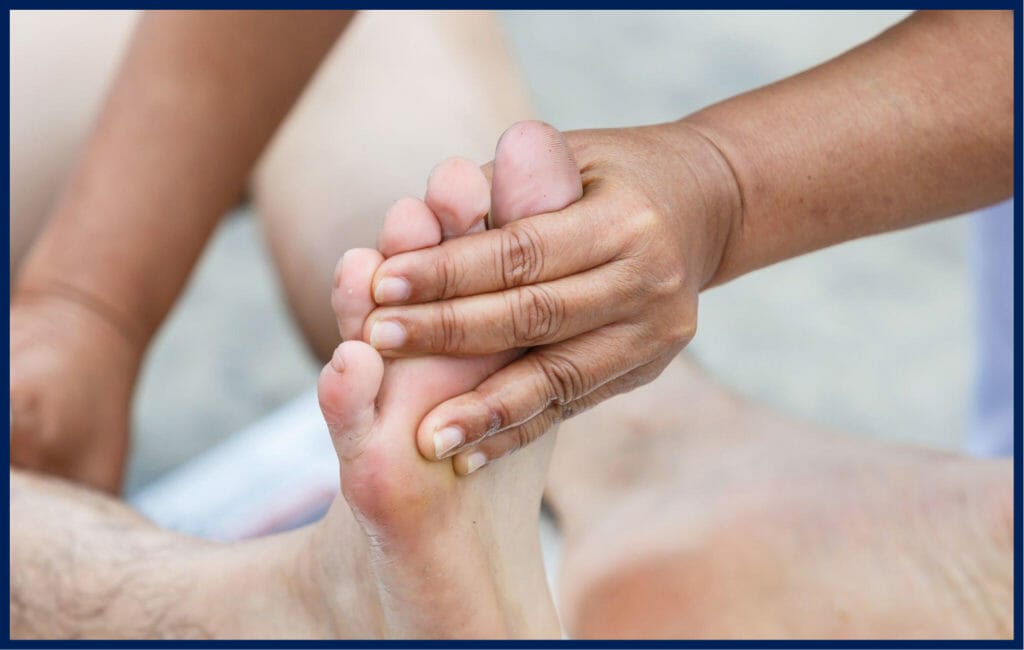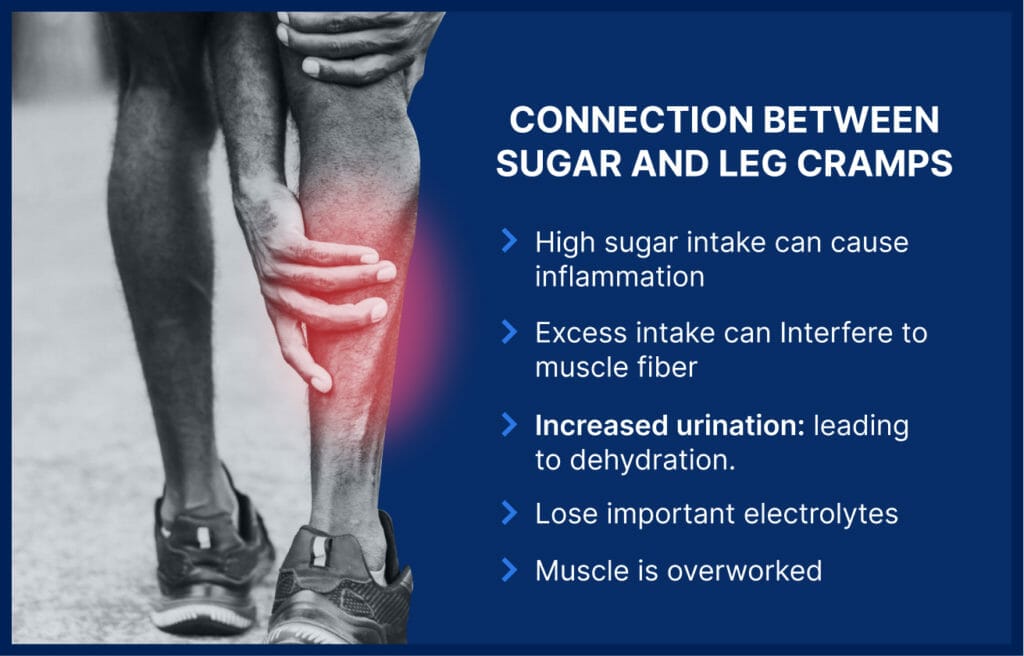The unusual connection between leg cramps and sugar intake is a topic that’s sparked considerable curiosity. Essentially, consuming large amounts of sugar may lead to mineral imbalance and dehydration in your body, triggering muscle cramps, including in your legs.
However, there’s much more to this sugar-cramp equation than meets the eye –– from how sugar impacts your muscular system to how drastic insulin spikes may induce cramps.
Buckle up, and let’s embark on this sweet yet crampy journey, revealing the fascinating science behind sugar’s effects on your body.
Understanding Leg Cramps

Leg cramps, also known as Charley horses, are sudden, involuntary muscle contractions that can occur at any time but are most common during rest or sleep. They can affect any leg part but most frequently occur in the calf muscles. Cramps can range from a minor nuisance to debilitating pain, often leaving a lingering soreness.
Common Causes of Leg Cramps
Understanding these typical triggers is a crucial step toward managing and preventing leg cramps:
- Overuse of Muscles: Overexerting or straining your leg muscles during physical activities like sports or heavy exercise can often lead to cramps.
- Dehydration: Insufficient hydration can imbalance your body’s electrolytes, which can cause muscle cramps.
- Mineral Depletion: A deficiency of vital minerals, such as potassium, calcium, and magnesium, can trigger cramps.
- Pregnancy: Changes in body physiology during pregnancy often cause leg cramps, particularly in the later stages.
- Certain Medications: Some medications, such as statins (cholesterol-lowering drugs) and diuretics, can cause muscle cramps as a side effect.
- Underlying Medical Conditions: Conditions like peripheral artery disease, diabetes, and thyroid disorders can increase the risk of leg cramps.
The Science Behind Sugar Consumption

Understanding the connection between sugar and leg cramps requires a basic knowledge of how your body handles sugar.
Let’s dissect this sweet matter to understand its benefits and potential harm.
How Your Body Processes Sugar
The metabolism of sugar, or carbohydrates, is a well-orchestrated process that starts in your digestive system.
- Digestion: When you consume foods with sugar, they’re broken down into simpler sugars like glucose in your digestive tract.
- Absorption and Distribution: This glucose is absorbed into your bloodstream, causing a rise in blood sugar levels. In response, your pancreas releases insulin, a hormone that helps distribute glucose to your body’s cells.
- Utilization and Storage: Your cells use glucose for immediate energy needs or convert it into glycogen for later use. Excess glucose may be stored as fat.
The Role of Sugar in the Body
While sugar is often vilified in health discussions, it’s important to remember that in moderation, it plays a vital role in our bodies. But, like most things, too much can tip the balance toward harm.
- Energy Source: Sugar, especially glucose, is a primary energy source for your cells. Your brain, for instance, relies heavily on glucose for its functioning.
- Stored Energy: Stored as glycogen in muscles and the liver, sugar provides energy your body can tap into when needed.
However, excessive sugar intake can have negative implications:
- Blood Sugar Imbalance: Consuming too much sugar can lead to blood sugar spikes and crashes, impairing your body’s ability to use insulin effectively, and possibly leading to conditions like type 2 diabetes.
- Dehydration and Mineral Depletion: High sugar consumption can lead to increased urination, potentially causing dehydration and depleting essential minerals — factors that may contribute to muscle cramps.
The Connection Between Sugar and Leg Cramps

Now that we’ve clearly understood leg cramps and the role of sugar in our bodies, let’s delve deeper into the intriguing connection between sugar and leg cramps.
Sugar’s Effect on the Muscular System
While sugar is a fuel source for our muscles, an overload of sugar can disrupt the balance necessary for optimal muscle function.
- Inflammation: High sugar intake can cause inflammation in the body, affecting muscle tissue and potentially leading to cramps.
- Interference with Nerve Signals: Excessive sugar can interfere with the standard transmission of nerve signals to muscle fibers, disrupting muscle coordination and increasing the risk of cramps.
Dehydration and Mineral Depletion
The way sugar impacts your body’s hydration and mineral balance is crucial to understanding why it can trigger leg cramps.
- Increased Urination: Consuming too much sugar can cause increased urination, potentially leading to dehydration.
- Loss of Electrolytes: With frequent urination, your body may lose important electrolytes like sodium, potassium, and magnesium, critical for proper muscle function and can trigger muscle cramps when depleted.
How Insulin Spikes Can Lead to Cramps
Insulin spikes, often a result of high sugar consumption, can contribute to muscle cramps in several ways:
- Interference with Electrolyte Balance: Rapid increases in insulin can lead to a temporary drop in levels of key electrolytes critical for muscle function.
- Increased Muscle Blood Flow: Insulin can also increase blood flow to muscles, which, while generally good, can cause problems if the muscle is overworked or has an electrolyte imbalance.
Managing Leg Cramps After Eating Sugar

Having established the potential connection between sugar and leg cramps, it’s time to explore how to manage and potentially prevent these painful episodes.
Lifestyle Modifications
An effective way to control leg cramps is to make conscious lifestyle choices directly in your hands.
- Balanced Diet: Include a variety of fruits, vegetables, lean proteins, and whole grains in your diet. These are rich in essential nutrients that can help reduce cramps.
- Moderate Sugar Intake: Try to limit your sugar consumption. Opt for natural sources of sugars like fruits instead of processed foods and drinks high in added sugars.
- Regular Exercise: Regular physical activity can help maintain muscle health, but remember, overexertion can also lead to cramps. Balance is key.
Hydration and Mineral Balance
Maintaining proper hydration and mineral balance can significantly reduce the occurrence of leg cramps.
- Stay Hydrated: Aim to drink enough fluids daily to keep your urine a light yellow color, a good indicator of proper hydration.
- Balanced Electrolytes: Consuming electrolyte-rich foods like bananas, potatoes, yogurt, and dark leafy greens or using electrolyte supplements can help maintain the balance of these crucial minerals.
Homeopathic Remedies
An example of a homeopathic remedy for managing leg cramps includes topical muscle relaxants. Delcorean offers an effective solution in the form of Cramp911 –– a muscle-relaxing lotion that users have reported to relieve a muscle cramp in as little as 15 seconds after application, providing relief for up to eight hours.
Cramp911 has been used for various muscle issues, from leg cramps to neck spasms, and has even prevented muscle stiffness and soreness after exercise. With a 96% satisfaction rating, this product might be a game-changer for those struggling with leg cramps, including those experiencing them after high sugar intake.
Take Control of Your Leg Cramps Now
Dealing with leg cramps after eating sugar can be a challenging experience. However, understanding the potential link between sugar and these painful episodes, combined with proactive lifestyle changes and the right treatments, can help you regain control of your life.
Cramp911 is a fast-acting muscle-relaxing lotion that has shown impressive results in managing leg cramps and various muscle-related issues. Click here to explore Cramp911 and start your journey to a cramp-free life today.


